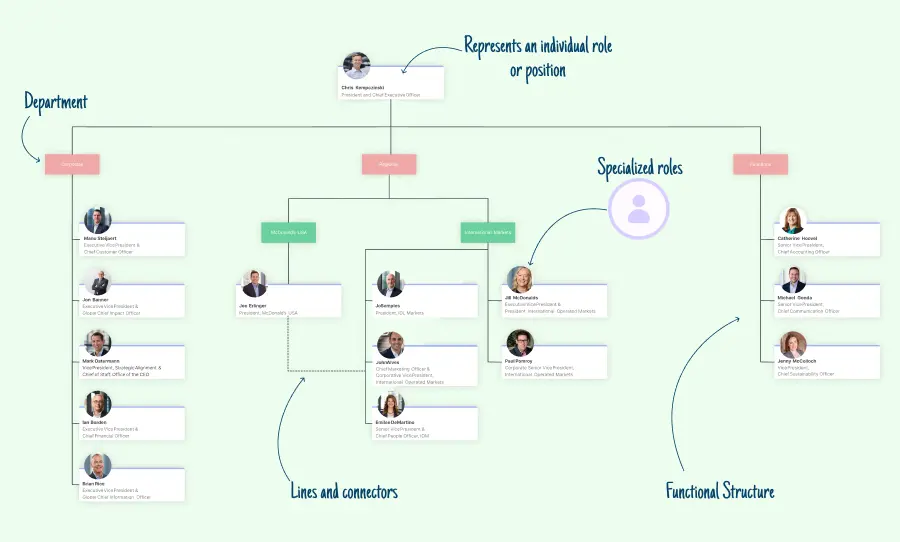Ever stared at a company org chart and wondered what all those boxes, circles, and lines really mean? Those shapes aren’t just decorative. They’re powerful organizational chart symbols that communicate roles, responsibilities, and reporting relationships at a glance. From a single department to an entire corporation, knowing the org chart symbols’ meanings helps you visualize hierarchies, streamline workflows, and improve team collaboration. In this guide, we’ll break down the most common org chart icons, explain their uses, and share practical templates to help you create clear, professional organizational charts that everyone can understand.
What Are Org Chart Symbols?
Organizational chart symbols are visual representations used to depict roles, responsibilities, and reporting relationships within a company or team. They help simplify complex hierarchies by turning positions and workflows into easy-to-understand shapes and icons.
These symbols can include rectangles, circles, lines, or specialized icons—each carrying a specific meaning. For example, a rectangle might represent a manager, a circle could indicate a committee role, and solid or dotted lines show reporting or collaborative relationships. Using consistent org chart symbols and organizational chart icons ensures clarity, improves communication, and makes it easier to identify team structures, responsibilities, and accountability within any department or organization.
Common Organizational Chart Symbols and Their Meanings
Organizational chart icons are essential visual cues that simplify complex structures, showing roles, reporting relationships, and communication flows at a glance. From a basic org chart icon like a rectangle for an employee to specialized symbols used in matrix structures, understanding the different organizational chart symbols’ meanings helps ensure consistency and clarity in your diagram. Below is a guide to the most common chart symbols and abbreviations you’ll encounter.

1. Boxes and Rectangles
- Standard Box: Typically represents an individual role or position, often labeled with the job title and, in some cases, the employee’s name.
- Box with Hatch Marks: Used to show a position that has direct reports and connects multiple layers of management, both above and below it.
2. Circles
- Circle with Horizontal Lines: Often signifies a committee or group role that requires approval from higher levels before further action or promotion.
- Circle with an Icon (e.g., a person): Used for specialized roles such as consultants, contractors, or managerial functions that don’t fit into the standard hierarchy.
3. Lines and Connectors
- Solid Lines: Represent direct reporting relationships, clearly showing the chain of authority.
- Dotted or Dashed Lines: Indicate less formal connections, such as advisory roles, collaboration, or dotted-line reporting structures.
- Connecting Lines Between Shapes: Map out the hierarchy and define how authority flows across different roles or departments.
4. Other Key Symbols and Elements
- Executive/CEO Symbol: Usually positioned at the very top, often with a distinct box or highlighted format to stand out.
- Assistant Role: Shown with a smaller box or uniquely placed directly beneath the manager’s symbol.
- Vacant Position: A placeholder symbol that marks a role that is open or waiting to be filled.
- Team/Department Frame: A visual border or grouping that clusters related positions together to represent departments or units.
5. Specialized Organizational Chart Icons
- Matrix Structure: Uses a mix of solid and dotted connectors to illustrate dual reporting relationships and cross-functional responsibilities.
- Functional Structure: Groups roles under departments like Marketing, Sales, or R&D, often using labeled boxes or icons.
- Divisional Structure: Represents divisions based on product lines, regions, or customer groups, with unique icons or separate clusters for each segment.
Free Organizational Chart Templates
Creating an effective organizational chart becomes much easier when you start with the right template. Instead of building from scratch, you can use ready-made org chart templates and simply customize them with the right organizational chart icons and role details. Below are a few examples you can adapt for different needs:
Company Organizational Chart Example
This template illustrates a traditional hierarchy, starting with executives at the top and moving down through managers to individual employees. It’s ideal for showing reporting lines clearly and helps teams understand decision-making flows.
Department Organization Chart
A department organizational chart shows the internal structure of a specific business unit, such as Marketing, Human Resources, Finance, Operations, or Sales. It visually maps out team roles, from executives and managers to specialists and support staff, making reporting relationships and responsibilities easy to understand. By using the right organizational chart symbols and icons, these charts highlight how tasks are distributed, how communication flows within the team, and how accountability is maintained.
Department org charts are especially useful for clarifying role boundaries, identifying gaps in staffing, and improving collaboration across teams. Whether it’s a marketing org chart, an HR org chart, or a finance org chart, these diagrams provide a clear picture of how each department functions and how it contributes to the company’s overall objectives.
Church Org Chart Template
A church organizational chart maps out religious leadership and ministry roles. From pastors and elders to volunteers and committee members, this template uses organization chart icons to make roles and responsibilities easy to recognize within the community structure.
Project Organizational Chart
Designed for project-based work, this template shows team members, roles, and responsibilities across different project phases. Using chart symbols and abbreviations, you can clearly define who is accountable for tasks and how collaboration flows between cross-functional teams.
Best Practices for Using Org Chart Symbols
Using organizational chart symbols effectively ensures your charts are clear, professional, and easy to interpret. Follow these best practices to make the most of your diagrams:
- Maintain Consistency: Use the same symbols for similar roles and reporting relationships throughout the chart. Consistent org chart icons help avoid confusion and make the hierarchy easier to follow.
- Use Colors and Abbreviations Wisely: Colors can highlight departments, roles, or reporting levels, while abbreviations should be clear and standardized. Avoid overloading the chart; clarity should always come first.
- Align Chart Design with Organizational Goals: Ensure the structure and symbols reflect the company’s workflow, priorities, and reporting system. A well-aligned organization chart icon system supports strategic planning and decision-making.
- Ensure Accessibility for All Viewers: Design charts that are readable for everyone, including those with color vision deficiencies. Clear labeling, proper spacing, and intuitive symbols make your organizational chart accessible and user-friendly.
Understanding and using organizational chart symbols correctly can transform a confusing hierarchy into a clear, visual representation of your organization’s structure. By applying consistent org chart icons, following best practices, and leveraging ready-made templates, you can improve communication, clarify responsibilities, and support better decision-making across teams. Start creating your own professional organizational charts today with these tools and templates, and bring clarity to every department, project, or business unit.
References
Business process and system modeling tools and packages. (2004). Practical E-Manufacturing and Supply Chain Management, pp.112–145. doi:https://doi.org/10.1016/b978-075066272-7/50008-7.
Bannon, J.J. (1982). The Organizational Chart: The Manager’s Toy. Journal of Physical Education, Recreation & Dance, 53(4), pp.47–48. doi:https://doi.org/10.1080/07303084.1982.10631093.
FAQs About Org Chart Symbols
Can organizational chart symbols differ across industries?
How do I choose the right symbols for my organizational chart?
Can I customize organizational chart symbols in software tools?
Which Org Chart Tools Offer Org Chart Symbols?






